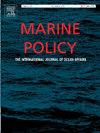海洋战略框架指令对软骨鱼做了什么和没有改变什么
IF 3.7
2区 社会学
Q2 ENVIRONMENTAL STUDIES
引用次数: 0
摘要
海洋战略框架指令(MSFD)是欧盟(EU)的一项法律,旨在在所有欧盟水域实现良好的环境状态(GES),其中包括海洋生物多样性(描述符1)和商业捕捞物种(描述符3)。软骨鱼可以在这两个描述符下被考虑。本研究详细介绍了22个欧盟沿海成员国(MS)如何在MSFD下考虑这些物种,并提出了解决差距和进一步管理和保护这些物种的建议。对国家和欧盟一级报告的审查表明,在国家努力达到全球生态目标和履行与MSFD下这些物种的保护和管理有关的义务时,不同程度地整合和考虑了软骨鱼。在欧盟海域的168种软骨鱼中,61种已被纳入其中一种或两种描述符下,只有39种在欧盟范围内进行了GES评估,结果有积极的也有消极的。然而,欧盟MS对现有监测计划的依赖确实阻碍了软骨鱼的有效数据收集,在物种状况、栖息地条件、生态和分布评估方面留下了大量数据缺口。这些差距因分散的做法而进一步扩大,而这种做法可以按照《指令》的要求,通过更好的区域合作和协作来解决。本文章由计算机程序翻译,如有差异,请以英文原文为准。
What the Marine Strategy Framework Directive did and did not change for Chondrichthyes
The Marine Strategy Framework Directive (MSFD) is a European Union (EU) law aiming to achieve Good Environmental Status (GES) in all EU waters, which includes, inter alia, marine biodiversity (Descriptor 1) and commercially fished species (Descriptor 3). Chondrichthyes may be considered under both descriptors. This study presents detailed insights into how the 22 coastal EU Member States (MS) have considered these species under the MSFD and provides recommendations to address gaps and further management and conservation efforts for these species. The review of national and EU-level reports showed a varied integration and consideration of Chondrichthyes in national efforts to reach GES and fulfil obligations in relation to the conservation and management of these species under the MSFD. Across the 168 chondrichthyan species occurring in EU marine waters, 61 have been integrated under either or both descriptors and only 39 species were assessed for GES across the EU, with both positive and negative outcomes. However, the reliance of EU MS on existing programmes for monitoring does hinder effective data collection for Chondrichthyes, leaving substantial data gaps regarding the assessment of species status, habitat conditions, ecology, and distribution. These gaps are furthered by a fragmented approach that could be addressed through better regional cooperation and collaboration, as required by the Directive.
求助全文
通过发布文献求助,成功后即可免费获取论文全文。
去求助
来源期刊

Marine Policy
Multiple-
CiteScore
7.60
自引率
13.20%
发文量
428
期刊介绍:
Marine Policy is the leading journal of ocean policy studies. It offers researchers, analysts and policy makers a unique combination of analyses in the principal social science disciplines relevant to the formulation of marine policy. Major articles are contributed by specialists in marine affairs, including marine economists and marine resource managers, political scientists, marine scientists, international lawyers, geographers and anthropologists. Drawing on their expertise and research, the journal covers: international, regional and national marine policies; institutional arrangements for the management and regulation of marine activities, including fisheries and shipping; conflict resolution; marine pollution and environment; conservation and use of marine resources. Regular features of Marine Policy include research reports, conference reports and reports on current developments to keep readers up-to-date with the latest developments and research in ocean affairs.
 求助内容:
求助内容: 应助结果提醒方式:
应助结果提醒方式:


